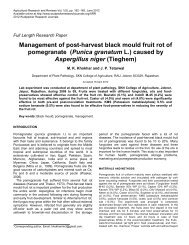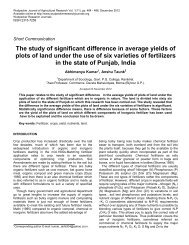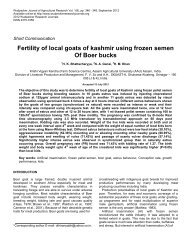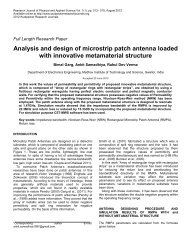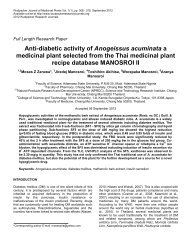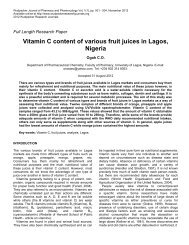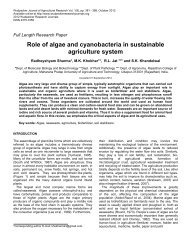Self concept and academic achievement of Kashmiri and Pakthooni ...
Self concept and academic achievement of Kashmiri and Pakthooni ...
Self concept and academic achievement of Kashmiri and Pakthooni ...
You also want an ePaper? Increase the reach of your titles
YUMPU automatically turns print PDFs into web optimized ePapers that Google loves.
77 Wudpecker J. Edu. Res.<br />
Table 1.4: Showing the mean comparison <strong>of</strong> <strong>Kashmiri</strong> <strong>and</strong> Pakhtooni<br />
students on <strong>academic</strong> Achievement (N= 50 in each group).<br />
Group<br />
<strong>Kashmiri</strong><br />
Pakhtooni<br />
N<br />
50<br />
50<br />
Mean<br />
57.06<br />
46.01<br />
S.D<br />
7.8<br />
6.25<br />
t-value<br />
7.81<br />
Figure 2. Mean comparison on <strong>academic</strong> achivement.<br />
t-value at 0.01 level <strong>of</strong> significance, which depicts that<br />
there is significance difference between <strong>Kashmiri</strong> <strong>and</strong><br />
Pakhtooni students on <strong>Self</strong> Concept Inventory. The<br />
above result clarifies that <strong>Kashmiri</strong> students have better<br />
<strong>Self</strong> Concept than Pakhtooni Students.<br />
In the light <strong>of</strong> above results, the hypotheses No. 1<br />
which reads as “There is significant difference between<br />
<strong>Kashmiri</strong> <strong>and</strong> Pakhtooni students on self <strong>concept</strong>” st<strong>and</strong>s<br />
accepted. (Figure 1)<br />
The table 1.4 shows the mean comparison <strong>of</strong> <strong>Kashmiri</strong><br />
<strong>and</strong> Pakhtooni students on <strong>academic</strong> <strong>achievement</strong>. The<br />
calculated t- value (7.81) is greater than the tabulated t-<br />
value <strong>and</strong> the difference was found to be significant at<br />
0.01 level. The above table revels that the <strong>Kashmiri</strong><br />
students show better <strong>academic</strong> <strong>achievement</strong> than the<br />
Pakhtooni Students.<br />
In light <strong>of</strong> the above discussion, the hypotheses No.2<br />
which reads as, “There is a significant difference between<br />
<strong>Kashmiri</strong> <strong>and</strong> Pakhtooni students on Academic<br />
<strong>achievement</strong>” st<strong>and</strong>s accepted. (Figure 2).<br />
MAJOR FINDINGS<br />
60<br />
50<br />
40<br />
30<br />
20<br />
10<br />
0<br />
57.06<br />
The following are some <strong>of</strong> the conclusions drawn from the<br />
present study.<br />
Level <strong>of</strong> significance<br />
0.01 Level<br />
46.01<br />
<strong>Kashmiri</strong> Pakhtooni<br />
1. It has been found that <strong>Kashmiri</strong> <strong>and</strong> Pakhtooni<br />
students differ significantly on ideal self dimension <strong>of</strong> <strong>Self</strong><br />
Concept inventory. The <strong>Kashmiri</strong> students were found to have<br />
better ideal self than the Pakhtooni students.<br />
2. It has been found that <strong>Kashmiri</strong> <strong>and</strong> Pakhtooni<br />
students differ significantly on real self dimension <strong>of</strong> <strong>Self</strong><br />
Concept Inventory. The <strong>Kashmiri</strong> students were found to have<br />
better real self than Pakhtooni students.<br />
3. It has been found that <strong>Kashmiri</strong> <strong>and</strong> Pakhtooni<br />
students differ significantly on overall dimensions <strong>of</strong> <strong>Self</strong><br />
Concept Inventory. The <strong>Kashmiri</strong> students were found have<br />
better self <strong>concept</strong> than the Pakhtooni students.<br />
4. It has been found that <strong>Kashmiri</strong> <strong>and</strong> Pakhtooni<br />
students differ significant on <strong>academic</strong> <strong>achievement</strong>.<br />
<strong>Kashmiri</strong> secondary students were found to have better<br />
<strong>academic</strong> <strong>achievement</strong> than Pakhtooni students.<br />
REFERENCES<br />
Mean<br />
Agarwal A (2002). Study <strong>of</strong> Relationship <strong>of</strong> Academic Achievements <strong>of</strong><br />
Boys <strong>and</strong> Girls with <strong>Self</strong>-Concept <strong>and</strong> Level <strong>of</strong> Aspiration, Indian J.<br />
Edu. Res., 21: 75-76.<br />
Anderson (2004). Psychology <strong>of</strong> Physically H<strong>and</strong>icapped children, Lond<br />
MacMilan.<br />
Bala M (1995). A Comparative Study <strong>of</strong> self <strong>concept</strong> <strong>of</strong> Deaf Children.<br />
Cited in Fourth Survey <strong>of</strong> Research in Education, New Delhi, NCERT.<br />
Banui Kuotsu (1992). A study <strong>of</strong> the Value’s <strong>of</strong> College Students in



